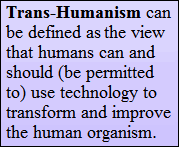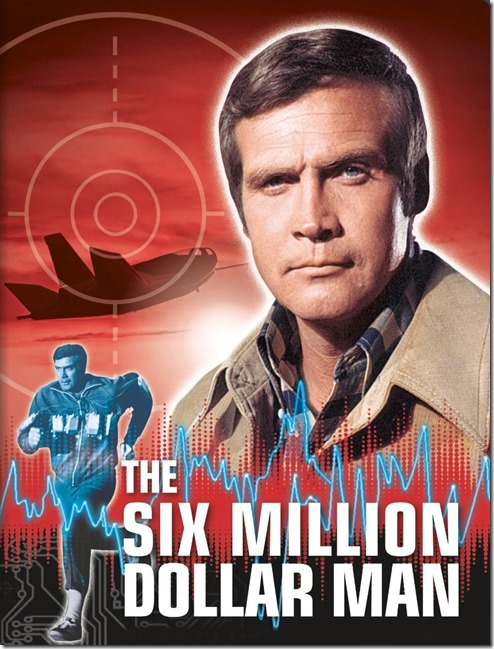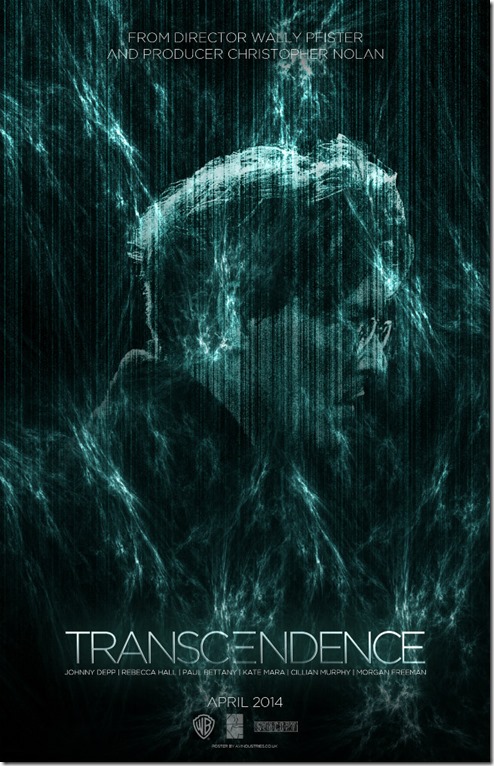I am crucified with Christ: nevertheless I live. Yet not I, but Christ liveth in me, and the life which I now live in the flesh I live by the faith of the Son of God, who loved me, and gave himself for me. (Galatians 2:20)
It is the beginning of the sixties, the first sixties ever, and St. Paul is disclosing his own personal transcendence, which he understands as redemption from Original Sin. He is no longer himself, but another lives in him – or is it through him? His very self is transformed and altered – it is no longer “he” who lives. Something very dramatic has happened to his spirit or his soul. As for his bodily life, the life he lives “in the flesh,” it is also changed: It is now lived “by the faith of the Son of God,” sustained, perhaps even animated, by a higher power.
 There is nothing new, then, in humanity’s attempts to transcend itself. Quite the contrary: Religion and post-humanism have been intertwined, sometimes even synonymous, since what has been called “the Axial Age” – in other words, the era, around the middle of the first millennium B.C.E., when religion and philosophy became self-reflective, universally inclusive and emphasized self-cultivation through ethical rites and processes. Indeed, the Moksha of Upanishadic Hinduism and Jainism, the Nirvana of Buddhism, the Ataraxia of the ancient Greek philosophical schools, and the redemptive “putting on” of Christ for early Christians – these are nothing if not post-humanist and trans-humanist visions thorough which the individual transcends and transmutes his or her self.
There is nothing new, then, in humanity’s attempts to transcend itself. Quite the contrary: Religion and post-humanism have been intertwined, sometimes even synonymous, since what has been called “the Axial Age” – in other words, the era, around the middle of the first millennium B.C.E., when religion and philosophy became self-reflective, universally inclusive and emphasized self-cultivation through ethical rites and processes. Indeed, the Moksha of Upanishadic Hinduism and Jainism, the Nirvana of Buddhism, the Ataraxia of the ancient Greek philosophical schools, and the redemptive “putting on” of Christ for early Christians – these are nothing if not post-humanist and trans-humanist visions thorough which the individual transcends and transmutes his or her self.
Truth be told, for almost 2,000 years, the West has turned its back on post-humanist projects, and busied itself with the proper construction of man. Partly due to its Judaic heritage, partly inspired by the Hellenistic traditions (especially the Aristotelian and Platonic), the Christianized Roman Empire sought to establish its association with Truth not through rejection of man, but by placing him (and sometimes her) in a proper dialogical relationship with God, or The One.
Being the ultimate Other, the transcendent divine of Jewish, Christian and Muslim monotheism held within itself the Truth , and required any who wished to partake of it to look to “Him” for answers. This yearning “upward,” toward the transcendent, ceased in the first centuries of the Common Era to be actualized through mystical ascent and apotheosis for all but a very select elite, and for most believers meant instituting an inter-subjective and dialogical connection with the great Other, often through sacred texts and rituals.
Through a process that Hegel would later refer to as the master-slave dialectic, this double-ended relationship intensifies and empowers not only the master – in our case, the transcendent God – but also the slave – in our case, the religious human. The Western perception of the human being was configured as an autonomous individual in large part through its understanding of itself as a dialogical partner engaged in an intentional relationship with the divine Other.
Humanism thus owes many of its roots to the religious traditions of transcendent monotheism. It is against and toward the transcendent divine that Renaissance man, and later the Protestant reformers, laid down the first tracks of the humanist project, a project that even at its highest ideological point, arguably at the end of the 18th century with the American and French revolutions, relied on God for the origination and continual securing of (what was beginning to be called by then) human rights.
It is not hard to understand, then, why the decline and final fall of the transcendent, monotheistic God has presented the humanist vision with a fundamental challenge. The destruction of the transcendent idea, brought about by the consolidated processes of the rise of the naturalistic perception of the universe, the de-mystification of life caused by the scientific revolution and the augmentation of inner-worldly and subjective sources of morality and authority (such as rational-analytic thinking, or inner – “spontaneous” and “natural” – feelings and passions) made the idea of a transcendent God either unnecessary or unthinkable, and brought about wide-ranging unbelief, on the one hand, and a different kind of religion, on the other.
It is to that last kind of religion that I will turn now, as I would like to propose that it is the basis for both the modern spiritual search, as displayed in the contemporary spirituality milieu (sometimes referred to as “the New Age”), and to the different groups engaged in a trans-human soteriological quest, based on technological achievements and scientific, or quasi-scientific, assumptions.
Singularity and monotheism
Now, when referring to the religious characteristics of the technological quest for the improvement and transcendence of man, I am not just addressing the obvious points of resemblance between ideas such as Ray Kurzweil’s “singularity” and monotheistic Messianism. As can be understood by the title of Kurzweil’s 2005 book “The Singularity Is Near: When Humans Transcend Biology,” there is not even an attempt to camouflage the clearly Messianic patterns of discourse.
I am also not speaking about groups such as the Raëlists, the Immortalists, the technopagans or the Luciferians, all of which have distinct religious themes and characteristics, and display clear and even conscious use of religious symbols and ideals.
I am referring rather to the structure of this religious quest, its form more than its content. For it is the form of religion that has fundamentally changed over the last few centuries in the West, leading to a process of secularization that is much more post-theism than a-theism. By post-theism, I mean a religion that is not centered around the grand old monotheistic transcendent king, but one that is concerned with what Foucault would call “the care of the self.” It is a religion that manifests itself less as a communal faith, based on collective rituals and rules of social conduct, and more as a personal spiritual quest, or in a word: an ethic.
It is not, then, only a matter of free choice and the private fashioning of the faith. The turn from traditional organized religion toward an individual voluntary one is also the turn from traditional ritual and law toward the individual’s concern with his or her own spiritual perfectibility. It is this change that we must note well, for it is this which ties the contemporary spiritual scene to the post- and trans-human projects at this time.
Now, to understand this religious metamorphosis, we must appreciate the dramatic consequences of the loss of the transcendental monotheistic god. Note that the assumption of a transcendental source of authority and truth is closely associated with a binary view of reality that presents clear dichotomies between presumed opposites such as this world and the next, nature and man, matter and spirit, body and soul, and man and woman. Moreover, in order to appropriately obey our God, we must fully embrace only one part of each binary couple, and seek divine truth by rejecting the latter and yearning, as it were, up and away from our earthly existence.
The elimination of the transcendent God has made this-worldly reality the focus of our religious life. It is in our present condition that we seek truth and redemption, through the phenomenal world as we see it, be it nature, our body, our mind or our feelings. A system of ethics, which regularly includes moral tenets and meditation practices, is supposed to bring us, by adherence to it, to full realization of religious redemption (whether spiritual liberation, emotional balance, or unification with nature).
In a way, this is a return to the transformative type of religiosity displayed by St. Paul, as mentioned above, and by Hellenistic Epicureanism and Stoicism, Upanishadic Hinduism and some strands of Buddhism. It is also the type of spiritual life we can sometimes find in the mystical traditions of the West, such as Sufism, Kabbalah, neo-Platonism and Hermeticism. What makes the current state of affairs in the West revolutionary in this respect is the magnitude and prevalence of this religious logic. From being the esoteric approach of a distinct elite, it has become the obvious and evident religiosity of the masses. Indeed, it is the dialogical “covenant” made with a transcendent God that has become a rarity in contemporary Western culture (though more in Europe than in the U.S. and Israel, of course).
I see trans-humanism, being the view that humans can and should (be permitted to) use technology to transform the human organism, as a specific creed within this major religious current. As with many New Age spiritual paths, it aimes to improve the individual condition in order to achieve superhuman goals, such as extended memory, bionic strength, full immunity to disease and even immortality. It thus offers a way towards private redemption, the difference from most of contemporary spirituality being that instead of a practical rule of ethics, it uses advanced technology for that purpose.
But the effort to improve and transcend the human condition is mutual. As Patrick Hopkins writes in an article entitled “Transcending the Animal: How Transhumanism and Religion Are and Are Not Alike”:
I see transhumanism as a reaction to the perceived oppressive and disappointing limitations of given human nature. Like religion – but unlike accepting or coping secular humanism – transhumanists want strongly to transcend the animal and actively work toward doing so. Unlike merely hoping that transcendence can occur, transhumanists aggressively pursue the physical practices, the technologies, that could make transcendence a reality.
What I would add to Hopkins’ account is that this specific type of religion, in which active effort is made to transcend the human “animal” in this very life, was, as stated earlier, quite rare in the West during the last two millennia, and has only since the second half of the 20th century become a wide-ranging, mass phenomenon. I wish to note that trans-humanism is located as a specific stream within this mass phenomenon.
The strategic flaw in the trans-human endeavor
And yet, there is a fundamental difference between the varied trans-humanist projects and the various spiritual paths, and it is this difference that eventually directs these enterprises toward quite opposite routes. We must remember that for almost all the religious mystical paths, transcending the human body was closely tied with transcending the human self. As St. Paul proclaims in the opening quote: “Yet not I, but Christ liveth in me.”
For Epicureanism, Ataraxia was achieved by understanding that the self is no more than a conflation of material particles, and not an ethereal soul. For strands of Hinduism, Moksha was realized when the individual understood that the Atman was in fact not the personal self, but identical with the one universal Brahman. For Buddhism, the goal was to realize that there is no separate self at all, and for different Hasidic courts, the self was the Godhead itself. Indeed, one could define the mystical quest (and I heard this brilliant definition from Moshe Halbertal) as the very process of gradual or abrupt de-selfization and de-individuation. These patterns of purpose and intention are still maintained within contemporary spirituality circles today.
In contrast to this, the trans-humanist project seeks to maintain the very same human self that exists at the outset of its path. That self may be improved upon, made stronger or smarter, may even be immortalized, but it will not be essentially changed, and definitely not annulled. I see this as a principal distinction between these two projects of “care of the self,” and as a strategic flaw in the trans-human endeavor.
The reason I see this as a fundamental mistake on the part of the trans-humanists (judging from their point of view, at least so long as they want to forward human freedom), is because the self that is imagined to be improved upon and immortalized is no more than a particular human cultural construct, specifically being the rational analytical self of the Enlightenment, itself a secularized version of the Judeo-Christian soul. This view of the human self was presented explicitly first by Rene Descartes, and fully developed in the works of Emanuel Kant. Taking this self to be the true or real human self is erroneous, and disastrous for any work built on that assumption.
To give a quick example of this assumption I would like to take two recent movies: “Her,” directed by Spike Jonze, and Wally Pfister’s “Transcendence.” In both these films, a human or human-like intelligence is “uploaded” or created to or in a computer. This intelligence acts as a sentient being, or in simple words – a self. On the other hand, this trans-human self has no physical body, and “moves” through cyberspace at will.
I propose this view of matters, shared by many post- and trans-humanists, is totally false, and is built, as said, on the Enlightenment’s secularized Judeo-Christian soul. As with the Judeo-Christian soul, it does not take into account the unbreakable bond between our mind and our body. I am not arguing that only brain tissue – and not silicon chips – can produce consciousness. I’m not a substance chauvinist and certainly believe that, as the saying goes, “it ain’t the meat, it’s the motion.”
What I am saying is that our consciousness is dependent on our body to understand itself as well as to function. I cannot go into this in proper length, and will just stress that we are embodied creatures and only through the body can we make sense of ourselves and our world. That is why we use our hands while talking, even on the phone. That is why we think better while walking. That is why our languages are filled with metaphors of space and time in order to comprehend mind and spirit. Indeed, even words like “superhuman” and “trans-human” are spatial metaphors, and “post-human” a temporal one.
In the film “Her,” the protagonist, played by Joaquin Phoenix, makes love to his artificial intelligent partner, and she actually has an orgasm – without a body. I think the very fundamental ways in which our body affects our feelings, emotions and consciousness and in which these are dependent on it are mistakenly ignored in this post-human fantasy.
To understand how much we are indebted to the Judeo-Christian soul when we imagine an out-of-body consciousness, I would like to suggest we try to imagine a cow’s consciousness being uploaded to a supercomputer. At first glance, it must be considered easier to upload a cow’s consciousness to a computer than that of a human, a cow’s consciousness being that much simpler. But we are unsuccessful in imagining a cow’s “self” living a virtual life within cyberspace. I believe we are unsuccessful in this because we grant special status to the human mind, and that because our view of it is, as said, the Enlightenment’s secularized Judeo-Christian soul.
When the female protagonist in “Transcendence” (played by Rebecca Hall) talks about her partner (Johnny Depp) and claims that “his mind is a pattern of electrical signals … we can upload his consciousness,” she is simply using pseudo-scientific mumbo-jumbo to secularize the idea of a separate soul, able to disconnect from the body. When her partner accomplishes said uploading and claims “my mind has been set free,” he is plainly delivering the trans-human secularized version of the “hallelujah” shouted by the religious individual reborn in Christ.
The view of the self in much of trans-humanism, is, then, no other than a secularized version of the Judeo-Christian soul, thrust through the prism of the Enlightenment and “technologized,” as it were, to update it for the 21st century. It is a particular view of the human self, time and culturally bound, and quite oblivious – as its archetype, the soul, was – to the fundamental and unbreakable tie between the mind and the body.
Following this philosophical blunder – another. This view of the human self is static within the trans-human project, meaning it is not to be changed or transformed, even while the human body is changed or transformed “around” it. This is fundamentally different, as stated earlier, from the dynamic view of the self in different spiritual traditions, a self going through metamorphosis.
Here we come to another principal difference within these two currents of the contemporary endeavor for the transcendence of man. As C.S. Lewis put it as early as 1944 in his The Abolition of Man:
For the wise men of old, the cardinal problem had been how to conform the soul to reality, and the solution had been knowledge, self-discipline and virtue. For magic and applied science alike, the problem is how to subdue reality to the wishes of men: the solution is a technique.
Or, we would say today, technology. And it is those wishes of man, subduing reality, that also disclose the ethical bankruptcy of trans-humanism, for when those wishes are fulfilled they will set human life in one determinate direction. Thus, changing reality instead of ourselves, we will perpetuate the dictatorship of our self as it is today, reducing choices and options for alternative lifestyles and setting the standard for any human existence to come.
As C.S. Lewis says, these future men will be “weaker, not stronger: for though we may have put wonderful machines in their hands, we have pre-ordained how they are to use them.” Without changing our selves, “Each new power won by man is a power over man as well.”
:
—
The article was presented as a lecture last month in a conference titled Oh Man Oh Machine: The Politics & Aesthetics of Posthumanism, Tel Aviv University. It was published yesterday in Haaretz.





